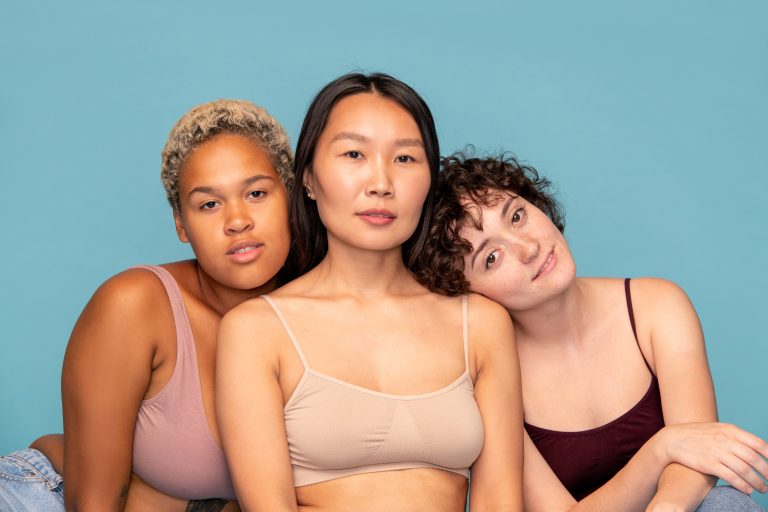You run your fingers through your hair—and notice more strands than usual.
Your ponytail feels thinner. There’s hair on your pillow, your brush, and the floor.
If this happens in your 40s or early 50s, you’re not alone.
Hair loss in perimenopause is common but rarely talked about—and deeply emotional for many women.
In this article, we’ll cover:
- Why hormone shifts trigger hair changes
- What’s normal vs cause for concern
- What you can do to support your scalp, strands, and confidence
Table of Contents
Toggle🧠 Why Does Perimenopause Affect Hair?
Your hair follicles are highly hormone-sensitive.
During perimenopause, several hormonal changes impact your hair growth cycle:
- Estrogen and progesterone decline → less stimulation of hair follicles
- Androgens (male hormones) like DHT stay steady or rise → contribute to thinning
- Thyroid and cortisol fluctuations also affect hair health and shedding patterns
These shifts can result in:
- Slower hair growth
- Shortened growth cycles
- Increased shedding or thinning
- Changes in texture (dry, brittle, or dull hair)
What Kind of Hair Loss Is Common in Perimenopause?
Most women experience one or more of these types:
1. Telogen Effluvium (TE)
Sudden, diffuse hair shedding. Often triggered by:
- Hormonal imbalance
- Stress or illness
- Nutrient deficiencies
Hair falls out more than usual, but follicles are still alive.
2. Female Pattern Hair Loss (FPHL)
Gradual thinning at the crown or part line is often hereditary and hormone-influenced.
3. Texture Changes
Even if you don’t lose hair, you may notice:
- Dryness
- Lack of volume
- Brittleness
- Hair that doesn’t “bounce back” like it used to
What’s Normal vs Not?
It’s normal to shed 50–100 hairs a day. During perimenopause, some women shed more like 150–200 daily.
When to pay attention:
- You see visible thinning at the scalp or part
- Your hairline is receding.
- Hair comes out in clump.s
- You’ve had sudden or severe lo.ss
Always rule out other causes like:
- Iron deficiency
- Thyroid dysfunction
- Autoimmune conditions (e.g. alopecia areata)
Expert Insight
“Hormonal hair loss is very real—and emotionally impactful. Many women feel isolated, but it’s one of the most common symptoms we see during perimenopause.”
— Dr. Sophia Kogan, Integrative Dermatologist
7 Ways to Support Hair Health During Perimenopause
You may not stop hair changes completely—but you can slow shedding, nourish growth, and support your confidence.
1. Check Your Hormones (and Support Balance)
Hair needs hormonal harmony to thrive.
Ask your provider to test:
- Estrogen
- Progesterone
- Testosterone (and DHT)
- Thyroid hormones (TSH, T3, T4)
- Ferritin (iron storage)
If estrogen or progesterone is low, or androgens are high, consider:
✅ Lifestyle changes
✅ Bioidentical hormone support
✅ Nutritional therapy
2. Reduce Stress & Cortisol Overload
Chronic stress = high cortisol → hair growth cycle disruption.
Try:
✅ Breathwork, yoga, walking
✅ Adaptogens like ashwagandha or rhodiola
✅ Magnesium glycinate at night
3. Eat for Your Hair
Your follicles need fuel—especially protein and micronutrients.
✅ Protein: Aim for 80–100g daily
✅ Iron: Red meat, lentils, leafy greens
✅ Zinc, biotin, selenium: Nuts, seeds, eggs
✅ Omega-3s: Salmon, chia seeds, walnuts
✅ Hydration: 2–3L water/day
4. Avoid Over-Washing or Heat Styling
Your scalp’s oil balance changes in midlife.
✅ Wash 2–3x/week max
✅ Use sulfate-free, volumizing shampoos
✅ Air dry when possible
✅ Limit tight ponytails or buns
5. Try Targeted Supplements or Topicals
Research-backed options include:
- Collagen peptides (support hair, skin, nand ails)
- Biotin + B-complex
- Topical minoxidil (Rogaine) – stimulates regrowth
- Pumpkin seed oil – may reduce DHT levels.
- Rosemary oil – increases circulation when applied to scalp.
Always introduce supplements one at a time and give at least 3 months to assess.
6. Sleep & Cycle Syncing
Sleep deprivation increases cortisol and slows growth.
✅ Wind-down routine
✅ Magnesium + no screens before bed
✅ Sync activities to your cycle (rest more in the luteal phase)
Better sleep = better hair.
7. Work With a Holistic or Hormone-Literate Practitioner
A personalized approach works best.
They can help with:
- Hormone therapy
- Blood work interpretation
- Natural or medical treatments
- Emotional support
You deserve a care team that takes your hair—and how it makes you feel—seriously.
Real-Life Story
“My ponytail was half the size it used to be. I was devastated. I started strength training, eating more protein, using rosemary oil, and switching to a hormone-friendly shampoo. It took 4 months—but now I’m seeing baby hairs. And I feel hopeful again.”
— Jess, 46
Myth vs Reality
| Myth | Reality |
| “Hair loss only happens to men.” | 40% of women experience hair loss by midlife. |
| “Nothing can help.” | With the right support, regrowth is possible. |
| “It’s just cosmetic.” | Hair is linked to confidence, identity, and mental health. |
What You Can Do Next
Hair loss during perimenopause is more common than you think—and nothing to be ashamed of.
You’re not vain. You’re not imagining it. You’re hormonally shifting—and your hair is responding.
Start by giving your body what it needs: nourishment, support, and time.
Sources (Research Links)
- NIH – Hormonal Hair Loss
- PubMed – Stress & Hair Shedding
- PubMed – Botanicals for Hair Loss
- North American Menopause Society (NAMS)
Anna Haotanto is the Founder of Zora Health and a passionate advocate for women’s empowerment. Anna’s personal experiences with egg-freezing, PCOS, perimenopause and the challenges of fertility have fueled her mission to provide high-quality information, financing, and support to help women and couples navigate their fertility journeys with confidence. She is also recognised for her achievements in finance, entrepreneurship, and women’s empowerment, and has been featured in various media outlets. You can also follow her on Linkedin or Instagram.




